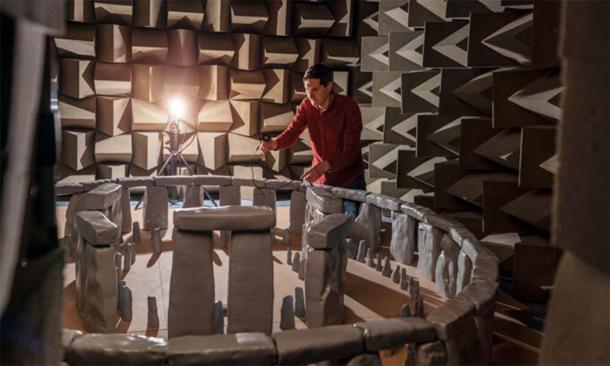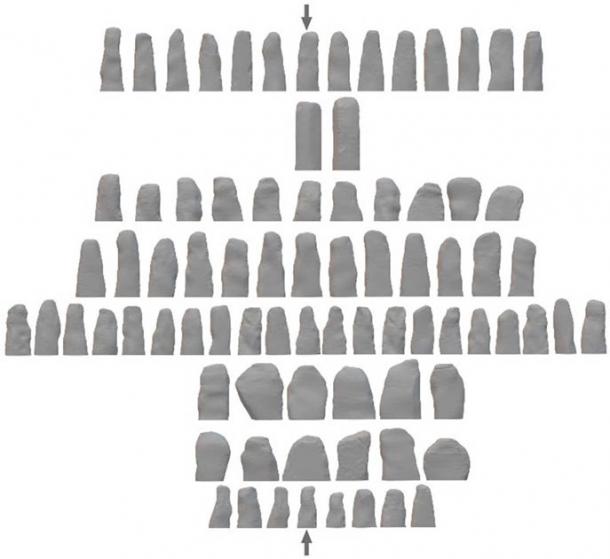A mini model of Stonehenge has been built in the UK by researchers using the latest technologies. They were interested in the acoustics of the structure that dates to the Neolithic period (2200 BC). The results show that Stonehenge had excellent acoustics, which is helping researchers to better understand the structure.
Trevor Cox and his colleagues, at the University of Salford in Britain, decided to make a replica of the famous sacred megalithic structure . The researchers needed their model to represent the stones still standing and also those that are missing: Stonehenge when complete had 157 stone. The Daily Mail reports that “to recreate the original shapes and positions of the stones, researchers began by using laser scanning data of Stonehenge’s modern-day configuration.”

Trevor Cox, an acoustic engineer, working with a 3D scale model of Stonehenge inside a sound chamber at the University of Salford. ( Acoustics Research Centre / University of Salford )
Studying the Acoustics of Stonehenge Lego
The team employed 3D printing technology to make 27 stones, while silicon molds were used to create the 130 other stones. This allowed them to create a complete mini Stonehenge. The “simulated stones were constructed to minimize sound absorption, much like actual stones at Stonehenge,” Cox told Science News . As a result, the team was able to create a complete acoustic model of what is perhaps the most famous Stone Age monument in all the world.
According to Science News , the model which Professor Cox has called “Stonehenge Lego” was placed inside the University of Salford’s acoustic chamber. A series of speakers that emitted sounds of various frequencies were placed on the model. In the Journal of Archaeological Science , the researchers wrote that “model stones were made impervious and heavy to minimize sound absorption.” The sounds were modulated so that the sounds coming from the speakers were as natural as possible.

The team employed 3D printing technology to make 27 stones, while silicon molds were used to create the 130 other stones. This allowed them to create a complete mini Stonehenge. ( Trevor J. Cox et al./ Elsevier / CC-BY-NC-ND )
Modelling Sounds From the Stone Age
Then the team used a technique used in virtual reality sound production. Cox told the Daily Mail that “it is the sound equivalent of visualization. We can virtually place a source of sound in a space.” The sound waves were measured by timing how long before the decibels degraded. The professor told the Daily Mail that “that’s enough to boost voices or musical instruments.”
The study shows that the voices of those in the stone circle and their music were amplified in a similar way to a modern cinema, even though the monument had no roof. Further studies showed that the model did not project sounds into the adjacent area. In the Journal of Archaeology , the experts wrote that the “monument does not facilitate the projection of sound out into the surrounding area, for example to an audience standing outside the stone circle.” The builders did not know that the stones would have produced an acoustic effect. The Daily Mail reports that “researchers believe they would have exploited the sound effects while singing or speaking.”

The study shows that the voices of those in the stone circle and their music were amplified in a similar way to a modern cinema. ( George Bailey / Adobe Stock)
Understanding How Stonehenge Was Experienced by Stone Age Britons
Stonehenge was built without any machinery and it is a true marvel of engineering. It was probably built by several groups over many centuries. There were many configurations of Stonehenge, dating back to 5,500 BC, and each one would have had its own unique impact on the acoustics. In the Journal of Archaeology the researchers state that the “most significant change to the acoustics during the various historic configurations examined was when the outer sarsen uprights were added. This would have increased the reverberation time by a noticeable amount.” It seems that the acoustics, and therefore the Neolithic Britons experience, of Stonehenge evolved over time.
Archaeologists have shown that Stonehenge served as a burial site from 5,500 to 4,500 BC. The site was also associated with astronomical calculations. Science News reports that the “designers of Stonehenge were likely less concerned about acoustics than about issues such as treatment of the dead and astronomical alignments.”
No one knows what type of rituals and ceremonies took place at Stonehenge, or who participated in them. The mini model does however shed some light onto these mysteries. The Journal of Archaeology states that the “results suggest that any sounds created within the stone circle were best intended for others within the same relatively intimate setting.” This contrasts with the large number of people who constructed the henge. Only a small number of them would have had the privilege to witness and experience the acoustics of the structure during ceremonies.
The study is allowing experts to understand the experiences of Stone Age Britons at Stonehenge. However, some have cautioned about reading too much into the research. A musicologist Rupert Till told Science News that a “wider range of acoustic measures is needed, for instance, to detect echo effects in the scale model that are also present at Stonehenge.”
Similar scale acoustic models are widely used in designing buildings where the acoustics are important, such as concert halls and music venues. However, this was the first time that anyone has made a scale model of Stonehenge. This study has done much to further our understanding of the famous Neolithic monument. It also shows how these models can be used to help experts to understand the acoustics of ancient structures and buildings and how they were experienced by people from past cultures.
Top image: A team from the University of Salford has built a scale model of Stonehenge to test the acoustics of the famous Neolithic structure. Source: Acoustics Research Centre / University of Salford
By Ed Whelan
Related posts:
Views: 0
 RSS Feed
RSS Feed

















 September 3rd, 2020
September 3rd, 2020  Awake Goy
Awake Goy  Posted in
Posted in  Tags:
Tags: 
















